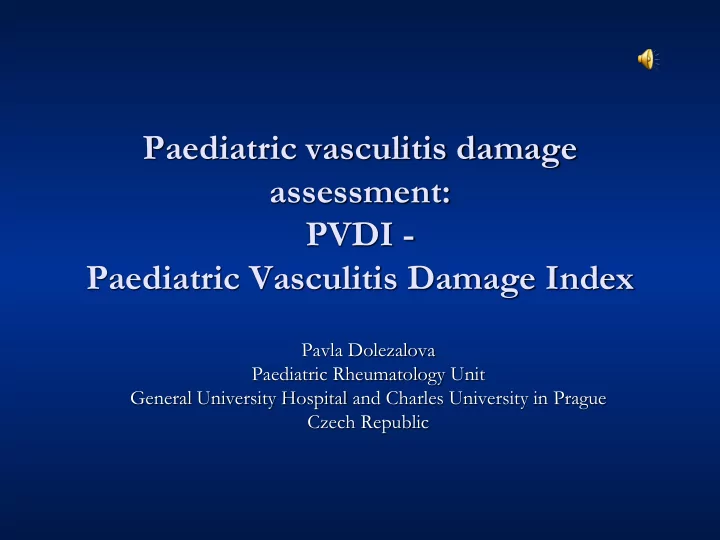

Paediatric vasculitis damage assessment: PVDI - Paediatric Vasculitis Damage Index Pavla Dolezalova Paediatric Rheumatology Unit General University Hospital and Charles University in Prague Czech Republic
PVDI development Based on VDI Delphi and NGT used to reach the current PVDI version Items re-grouped to 9 organ systems (peripheral vascular system deleted) Retains original VDI items (64) + 8 paediatric ones Distinguishes items currently present and those that have resolved Glossary adapted for the paediatric use School absence assessment added Formal validation not yet completed
PVDI 9 organ based systems + Other section Each item scores 1 point Item definitions in the PVDI Glossary
Paediatric Vasculitis Damage Index Glossary Disease damage is defined by duration of the sign/symptom as at least 3 months any time since the onset of vasculitis The item does not need to be present at the time of scoring (NLP – No Longer Present) Some of the items and their description are very similar to those of the PVAS DURATION and NEED FOR INCREASED IMMUNOSUPPRESSIVE TREATMENT are the main distinctions
Damage is defined as irreversible in principle This applies also to features that may have disappeared by the time of your current evaluation “irreversibility“ a long-standing (3 months arbitrarily chosen) general impact of an item on patient ´ s life not necessarily causing a life-long persistent physical sign (“scarr”) E.g. failure to thrive or delayed puberty = NLP Majority of items represent true scarring E.g. tissue loss, nasal bridge collapse, any surgery = always present PVDI list can only remain stable or deteriorate over time. The PVDI does not improve with time
The PVDI items may be present: 1. As a direct consequence of vasculitis disease activity 2. As a consequence of vasculitis therapy 3. Or as a consequence of related or unrelated comorbidity that develops or deteriorates after the onset of vasculitis
Features of damage to score as „ Present “ present for ≥3 months and are still present at the time of the assessment Features of damage to score as NLP ( “No Longer Present” ) present in the past starting after the vasculitis onset lasting for ≥3 months resolving by the time of the assessment Note also that you cannot score any single item as “present” and “NLP” at the same time.
During long-term follow-up some damage items may move from the “Present” box to the “NLP” (No Longer Present) box The PVDI score can only remain stable or deteriorate over time both “NLP” and “Present” damage items carry a numeric score of 1 and no item can be scored under both at once
OTHER section Lists general items that are not organ-based Additional items can be added in handwriting based on their clinical significance as assessed by the physician and/or the patient E.g. renal transplantation or insertion of a dialysis catheter
Repeat episodes In the case of blindness, myocardial infarction, loss of pulses, major tissue loss, or stroke, repeat episodes may be recorded (in Other section) ONLY if at least 3 months apart For example, blindness in the left eye would score if present for ≥3 months; if blindness in the right eye then developed, this would only score on the PVDI when present for ≥3 months.
„Double“ scoring The same pathological feature cannot be scored in more than one organ/system section Example: optic atrophy - cranial nerve lesion, atrophy of interosseal hand muscles associated with ulnar neuropathy Each feature of damage is scored, but not more than once except in cases in which the same item of damage has occurred in the contralateral organ.
„Multiple“ scoring Each pathological event causing damage May be scored by one or more damage items within that system category This may reflect its clinical importance/severity E.g. cataract with/out visual impairment, pulmonary fibrosis with/out pulmonary hypertension, coronary stenosis with/out myocardial infarction etc.
PVAS vs. PVDI Some items may appear similar in PVAS and PVDI (eg. Bowel ischaemia or Stroke) Count as Activity item if Present at the initial assessment (regardless their duration) Present for less than 3 months If the Bowel ischemia or Stroke has occurred within 3 months of the last PVAS and PVDI assessment, it is scored in PVAS as active disease, not as damage in the PVDI Count as Damage item if Present for longer than 3 months any time since disease onset Items should NOT be scored on both the PVAS and PVDI: events are either disease activity or damage, but never both at the same time.
Recommend
More recommend